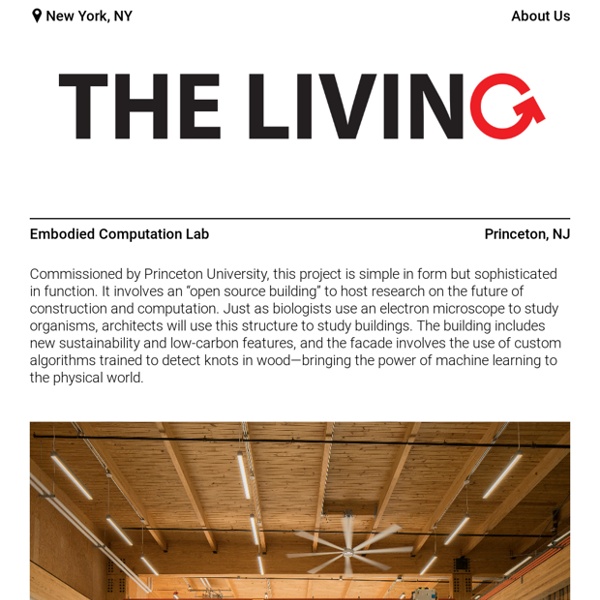



Cibic Workshop T + E + A + M portfolio — Hana has a solid architectural background with Master's degree on Landscape Urbanism at the Architectural Association School of Architecture in London, UK. Her major study focuses on Urban Regeneration, Landscape Infrastructure, and Sustainable Development of Buildings and Cities. 3-4 years professional practice as architect at design firms such as ARUP and Graftlab, and recently shifting her practice into Urban Masterplanning and Landscape Design in Mainland China. Major experience as urban designer includes key designer at Groundlab in London, and project architect at Plasma Studio in Beijing. Currently participating in Hong Kong as urban designer and project manager. Proficient in parametric design, comprehensive design, systematic design, LEED, and sustainable design. Her personal interests include resort design, graphic design, interior decoration, and art installations.
projektowa peg office of landscape + architecture Philadelphia, like many cities that have shifted to a service economy, is reinventing its waterfronts. A series of recent planning and regulatory initiatives are underway, which aspire to transform the Delaware River from a transportation utility into an ecological and recreational resource (i.e. Green City, Clean Waters; Master Plan for the Central Delaware; Estuary Restoration Act). Our project, Testing the Waters, explores wetland suitability strategies that are directly guided by energy and elevation parameters, collected and modeled by us, through the computational capacities of geospatial analysis (GIS), computational flow dynamics (Aquaveo SRH-2D), and parametric software (Grasshopper).
peg office of landscape + architecture About pegAn approach to every scale PEG office of landscape + architecture is an award-winning design and research office based in Philadelphia, Pennsylvania. They engage a variety of projects in terms of content, scale, and medium, ranging from immersive interior environments to large public spaces. PEG's work explores the relationship among digital media, fabrication technology and construction. Through new media and fabrication technologies, PEG's work explores methods of systemic patterning to expand landscape's expressive agency in the shaping of the public realm. Their projects experiment with formal and temporal patterns; in all cases, these methods are used to craft variation in surface appearances, as well as participate in site functions, such as water collection, plant growth, and maintenance zones. Bios Karen M'Closkey Karen is an Associate Professor of Landscape Architecture at the University of Pennsylvania. Keith VanDerSys Jeff Sharpe
nomad.studio : landscape architecture : landscape planning Organization : opsys A land-based project office dedicated to the generation of new media and alternative forms of knowledge to help conceive actionable research and transformative strategies related to pressing and long-standing territorial challenges that are material, social, ecological, and political in scope. Conceived as part-laboratory, part-studio, and part-workshop, OPSYS addresses complex, spatial, and historical issues—through detail and precision, through diagrams and approximations, through models and prototypes—by the design and development of simple, grounded strategies as the basis for open-ended, adaptable, yet resilient infrastructures, across a range of scales, that support and promote a multitude of future, contemporary, and traditional forms of life. OPSYS, and its implementation arm LANDSCAPE INFRASTRUCTURE LAB, are founded and directed by Pierre Bélanger. ©2001-18 OPSYS.
Landezine International Landscape Award LILA NODE stands for Nansha Original DEsign Tracing Animal Movement Patterns Dennis Hlynsky (1952 Ohio) resides in Providence, Rhode Island where he is a professor and the Chair of the RISD Film/Animation/Video Department. He is a practicing artist and an early adopter of electronic media. Drawing and photography were primary studies but soon gave way to video in 1972. Dennis incorporated ever evolving electronic media technologies into his artistic practice. Digital technologies provided a refreshing outlet for continuation of the early experiments with analog video synthesis. Selected exhibits include – Hiroshima City MOCA, 3/2016; National Museum of Wildlife art of the United States; Tazmanian Museum and Art Gallery, Spring 2016; Höhenrausch, Summer 2015, OK Center for Contemporary Art, Linz; Trans-ideology: Nostalgia, MOCA Taipei, 20/2015, Transartfest, Berlin, Germany 2013, For the Birds Palo Alto Art Center, Jan 2016; The Imagine Science Film Festival, 2014, Brooklyn, NYC Tell us about the 5 featured films on Labocine? flight of a small brown moth